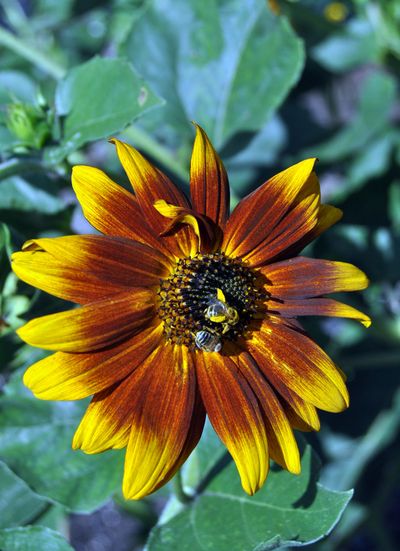Pat Munts: Bees, birds, humans enjoy sunflowers

It’s sunflower season. It’s hard to miss the towering plants with their huge yellow to red flowers peeking over the tops of fences and making hedges at the edge of gardens. They seem to be celebrating the end of the hot summer and will continue the celebration until the frosts take them down.
Sunflowers, or Helianthus, are a group of 52 species all native to North America mostly in the Midwestern prairies. They are easy to grow and will reseed liberally if given the chance. I haven’t planted a sunflower in my garden for 15 years, relying on seeds pulled out of the flowers by the birds and dropped into the soil. The flower is made up of a ray flower of colored petals around the head and a disk flower that makes up the big center portion of the flower where the seeds grow.
Sunflowers will grow anywhere there is full sun and fast-draining soil. They do prefer a slightly acidic to alkaline soil (pH 6-7.5), which is quite common in our area. They need long, hot, sunny summers to bloom profusely, and most are quite drought- and heat-tolerant. As some of you probably noticed in our recent spate of windstorms, they do need protection from wind so planting them along a fence or in clumps will help keep them upright.
Late summer bouquets of sunflowers are all the rage at local farmers markets and are a wonderful addition to bring a little summer indoors. Cutting your own bouquets takes a little planning. Cut flower heads in the early morning when they are just beginning to open. Leave a 12-inch stem, if possible. Take a 5-gallon bucket of cool water with you and immediately place the cut flowers in the bucket. Once you are ready to arrange the flowers, remove each flower from the bucket and cut a couple of inches off the base and immediately place it in your vase of water. Remove the yellow pollen from the flower as it will stain fabrics. Change the water daily and your bouquet should stay fresh for about a week.
Sunflowers are a valuable source of pollen and nectar for honeybees, bumblebees and butterflies. Right now there are clouds of the insects around my sunflowers, and it isn’t hard to find a honeybee with bright yellow globs of pollen being held in the bee’s pollen baskets on its hind legs. The bees store the pollen in their hive as a protein source for larvae and for winter stores. Sunflower seeds are also a source of food for finches, chickadees and nuthatches through the fall and early winter.
Yellow is the plant’s natural color but hybridizers have developed a beautiful range of reds, yellow-browns and whites. The plants come in sizes from Elf that grows 14 to 16 inches tall, to Teddy Bear that gets 2 to 3 feet tall, up to Mammoth that can reach 10 feet or taller.